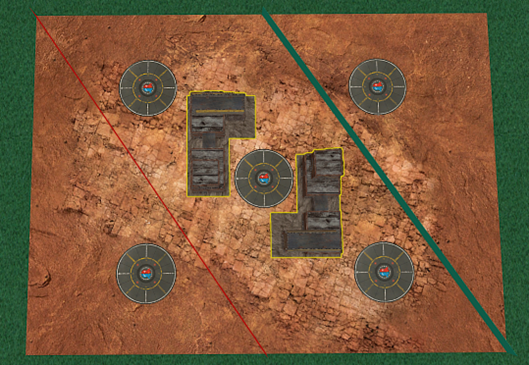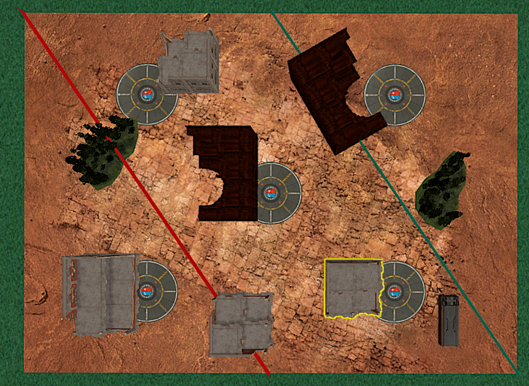FLG Terrain and You: Or How I Learned to Love Fixed Middle Ruins
Author: Jeremy Atkinson
It’s no secret that members of Stat Check have strong opinions on player-placed terrain (PPT). There are a few issues with the current PPT system as well as the terrain used at FLG events. The current system implemented by FLG at their events is given below:
Terrain Placement Rules: terrain is divided as shown in the images below along the centerline of the deployment map rolled. Note: The line shown in the images is an example, and will differ based on the map rolled but is used as an example of how the map would be divided in half for a “Hammer and Anvil” style deployment.
The Defender chooses their table side and players separate the terrain as shown in the images below. Note, this is a deviation from the normal order of operations. Starting with the Defender, players alternate placing 1 piece of terrain from their half of the terrain in their table half at a time until all terrain has been placed. All the terrain pieces must be placed.
Note: the Orc table has a building in the center that is not moved unless an objective must be placed in the center of the table. In this instance, the Defender adjusts that piece of terrain as their first terrain placement, the minimum distance along the centerline to make room for the center objective. This will result in the building being moved in one of only two directions along the centerline with the intent to keep it as equally in either players’ table side as possible. If you are using neoprene objective markers please ensure that you are placing or adjusting terrain to account for where the 40mm objective is supposed to be in the center of your objective marker.
Note: If either player has a Fortification, they may place it on the table for the purpose of measuring space during this step, but it will be deployed following the normal rules.
Terrain must be at least 4” from a table edge or another piece of terrain.
Terrain marked with an asterisk must be at least 6” from another piece of terrain marked with an asterisk.
Note: In the instance one or more players has a model that has a footprint more than 6” in diameter in their narrowest measurement such as a Brass Scorpion, adjust terrain as needed to allow them to be able to traverse the board. When placing terrain, if it is found a model cannot fit through a 4 inch gap, AND it cannot legally move up and over the terrain using it's full movement, then move the terrain the minimum distance necessary to allow the model to fit through. Note: Full movement, means a model's furthest movement tier without advancing. Call a judge for assistance as needed.
In the instance one or more players has a Fortification, place them during terrain setup treated as an additional terrain feature for the owning player (meaning they may only be set up in their half of the table) following normal rules for Fortification placement per the rule book.
Layouts that have multiple cargo containers assigned to a player's half of the terrain are permitted to stack the cargo containers on top of one another or to use them to cover separate areas of the table following placement guidelines above. Cargo containers cannot be placed vertically and must have their longest sides parallel to the tabletop.
This article has been written to provide constructive criticism to the above system of terrain and provide some solutions to the two biggest issues we perceive with FLG terrain. We welcome all discussion and debate about this - feel free to reach out to the author if you have any feedback!
Example: Mission 12 – Tear Down Their Icons
No Attacker/Defender advantage in the mission (a la Mission 33), so you always want to select the first terrain drop per the FLG player placed rules if you win the Attacker/Defender roll off and here’s how this can be abused to gain a significant advantage.
First Drop Advantage
Let’s say you’re playing a top of the meta melee army (varies over the last year, but Drukhari, Sisters, Custodes, Tyranids are all excellent examples, and all rely heavily on Infantry builds to control the board). To gain maximum impact from this, you drop your first ruin on the centre objective.
By dropping the first piece on the middle objective, you achieve two things: you give your melee army a safe staging zone, and you zone out any other terrain from the middle that your opponent may want to use. You can protect yourself against enemy charges by placing your models such that they can’t be charged through the wall, and project your own force outwards.
Alternatively, if you’re playing a gun-line army like T’au, Iron Hands, etc. you can zone out the middle and create superb firing lanes by placing a container on the centre objective.
In our local meta, we encountered both of these issues on the regular, and came up with the following solution. We play with WTC-style ruins, as shown below.
Each player is given 2 large (3-story) ruins and 2 medium (2-story) ruins as well as 4 crates, one forest, and one vent. To mitigate the ‘first drop’ advantage, the following solution was devised: one of each of the medium ruins are taken from each player’s pool and are placed in the centre of the map, with the long edges facing the player battlefield edge. This blocks out the middle of the board, but does not provide an overly advantageous staging ground to either player. It also does not create a “killzone” for shooting armies but still leaves some fire lanes open. The rest of the terrain is then placed by the players with the normal rules for PPT as shown at the beginning of this document.
The other solution that has been tested is having a “null-zone” in the middle of the board - no terrain within 6” of the centre. This has a similar effect and works when you don’t have access to medium-size L-shaped ruins. It does have the disadvantage of still allowing melee armies to have a strong staging ground and allows for wider shooting lanes for gun-line armies.
With FLG terrain either of these solutions would be amenable - see an example of the Ork terrain set with the middle ruins located around the centre of the map. The medium-sized L-shaped ruins (Barracks) are used to achieve the same effect as above.
First Floor Line of Sight Blocking
The second major issue with FLG terrain is that most of the large ruins (e.g. Cathedral set) don’t block line of sight on the first floor. Why is this an issue? They have extremely large footprints, but no angles to hide units behind for the most part. Due to how obscuring works, this means that you cannot use them to hide your army and instead have to stage your army significantly further behind. This also opens up your army to being shot at more easy to achieve angles. For example, let’s say you wanted to hide 7 Possessed behind the yellow ruin:
While this looks simple enough to do, remember you cannot set foot on the ruin itself because you would then be visible.
This is the optimal position for them, but this still gives your opponent many angles to shoot at them:
(sorry for the map change - had to make the sightlines more visible)
If instead the first floor line of sight was blocking (just the windows in this case), you could then safely position the possessed, while they could still be targeted from a few angles.
Concluding, we feel that the quality of play and player experience at FLG events could be significantly improved by making the following changes:
Adjusting PPT rules to account for the first drop advantage by:
a. Determining a fixed centre orientation for two ruins from each set
OR
b. Setting a “no man’s land” region of ~6” from the centre of the tableMaking first floor ruin walls line of sight blocking (similar to what is done at the GW US Open events).










